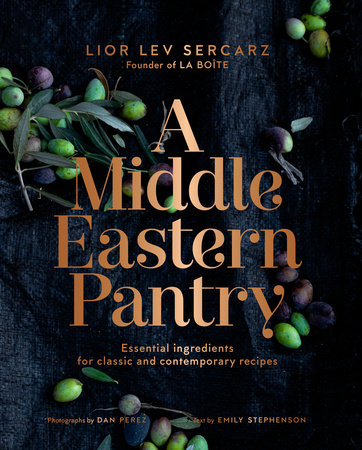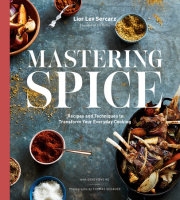Introduction Pantry cooking is not just for times when grocery shopping feels like too much of a chore. It’s not about reaching into the dark corners of your cabinet to miraculously pull together dinner on a weeknight. For me, pantry cooking is the best kind of cooking. I love the ingredients that fill my shelves because I choose them with purpose—my pantry is a curated selection of items that add complexity, texture, richness, spice, acid, and more to whatever I’m making. Having a pantry that excites you can yield a more accommodating and flexible way of putting together a meal that allows for improvisation. Fresh produce or meat are essential, but you can’t turn them into delicious meals day in and day out without these staples. (And, of course, there are some meals that are entirely based on pantry items.)
I was born in Israel and spent most of my childhood on a kibbutz in the north of the country. I roamed fields and orchards freely and foraged for pine nuts and berries with friends and for capers with my grandfather. While the food on the kibbutz was Ashkenazi Jewish–influenced, I was able to explore many of the various dishes of the Middle East when I went to friends’ houses. Tasting extraordinarily flavorful dishes like gormeh sabzi made by a friend’s mother was a formative experience for me. I soon learned about the food of my Iraqi, Turkish, and Egyptian neighbors.
When we traveled to the local market or visited family in other regions, street food was the main way I explored the food beyond our kibbutz. “Ethnic” restaurants didn’t really exist in Israel in the 1980s, but there were plenty of stalls and carts at every market. Throughout the Middle East, a food market isn’t just for shopping— there’s also a sense of exploration. The market is where I first sampled Iraqi sabich sandwiches drizzled with amba (page 59), flaky Turkish bread called simit (page 133), and succulent shawarma seasoned with its namesake spice blend (page 37). The markets are one of the things I miss most now that I’ve moved away.
I finished school, and during my time in the military, I realized how much I enjoyed cooking in the barracks and decided to become a professional chef. I worked in kitchens in Israel for several years, then moved to France to attend culinary school. I interned at the Michelin three-starred restaurant Les Maisons de Bricourt in Brittany—and it was there that I learned what extraordinary ingredients spices could be. The experience was remarkable.
After a few years cooking in France, I moved to New York City, where I continued my restaurant career working for Daniel Boulud. But after many years of the fast-paced, late-night, long-shift work, I needed a change. That’s when I opened my spice business, La Boîte. And for the last decade-plus, I’ve focused my passion for cooking, culinary exploration, and working directly with farmers on spices (and other essential ingredients) on sourcing the best possible products for my customers. When I visit farms, I get to indulge my passion for learning about the origins of the foods we eat. Then I bring that knowledge and enthusiasm to my customers’ tables through storytelling.
I really do believe that my loves of Middle Eastern pantry items and the region are deeply intertwined. Only now that I’ve been away for over twenty years do I see that I took it all for granted. Leaving the Middle East has given me a much better appreciation of the food I grew up with. I wish I had cherished it as much then asIdonow.Iwassoluckytogrowupinafarm environment, to see the ways our communities were preserving agricultural products and the role the pantry and preservation play in the magnificent cuisines of the Middle East. Since the dawn of agrarian societies and because of the hot climate, cooks in the Middle East have had to preserve almost all of their harvests, from spices and grains to legumes and vegetables, to make long-lasting pantry staples.
As a chef who has worked on multiple continents and now calls New York City home, I still turn to these flavors and ingredients for inspiration—more so than ingredients from anywhere else. Most of them live in my pantry today. The ingredients I feature throughout this cookbook are an important part of my culture and history—and of so many others. This region’s cuisine and its significance deserve to be celebrated. Plus, the ingredients are so versatile and translate very well to other cuisines you may cook, be it Moroccan, Indian, Italian, or Mexican, which makes them invaluable additions to your pantry.
I’ve divided this book into chapters based on pantry categories—for example, Nuts (page 98), Molasses (page 156), and Legumes (page 226). In addition to a basic description and recipes for using these ingredients, I offer more context about their history, agricultural origins, and how they’ve been traditionally made. I have a passion for sharing the origins and deepening our understanding of the food we eat. It’s a huge part of the storytelling I do with my spice business, La Boîte, and in all the books I’ve written. I want readers of
A Middle Eastern Pantry to think about where all of our food comes from—our capers and sesame seeds as well as our meat and fresh produce—which I think is a much bigger, culturally accepted conversation, especially when it comes to sustainability and quality. At their most basic, items in cans, jars, and bottles, like tomato paste, tahini, and rose water, are agricultural products captured at their peak by skilled and knowledgeable farmers who made them with care, using traditional preservation techniques. We take so many of our shelf-stable items for granted. It’s time to celebrate them.
Perhaps you’ll even be motivated to make some of these pantry staples yourself. There’s nothing wrong with commercially produced ingredients, but I think it’s exciting and important to take ownership of
almost everything you make (you can skip making homemade tahini, which was never as good as store-bought in my experimentations!) so you know exactly what was used to make the torshi you’re serving with dinner or the grape molasses in the salad dressing for Goat Cheese, Grape, and Walnut Salad (page 165). Preserving fresh produce will connect you to the whole cycle of seasonality, not just the harvest. We get so caught up in freshness and enjoying produce at its peak that we forget we can be eating these ingredients year-round in different, preserved forms: dried, pickled, fermented, and cured.
This is not meant to be the ultimate authority on the pantry items and recipes of the region, but a celebration of
my Middle Eastern pafntry. I’ve included dozens of my favorite ingredients that I use daily at home, and recipes to help you incorporate them into yours. Many of the recipes are my interpretation of traditional dishes, often made easier for the modern cook. I will always take the time to learn the history of a dish, but as a chef, I’m constantly reinterpreting what I experience. My versions of some of these dishes are not meant to be the definitive recipe or to disrespect the original (try telling any Middle Easterner that stews are easier made in an oven). I believe that first we must understand where our culinary building blocks come from and why ingredients are used in certain ways—whether that’s due to agricultural constraints or cultural significance. Then, by incorporating and interpreting them in our modern-day cooking, we can all help preserve—pun intended—these traditional ingredients and foods.
A fully stocked home pantry is what can make you a better, faster, more creative cook. It also can provide you peace of mind—I know that when I get home from work to make dinner for my family, having fantastic ingredients on hand to create an exceptionally tasty meal becomes many times easier. The addition of a new spice mix, fruit molasses in place of sugar, or a bit of cured meat can take a familiar dish to another level. These are flavorings and ingredients I get excited about using—and I want you to as well.
Yalla!
To the pantry . . .
Copyright © 2023 by Lior Lev Sercarz. All rights reserved. No part of this excerpt may be reproduced or reprinted without permission in writing from the publisher.











